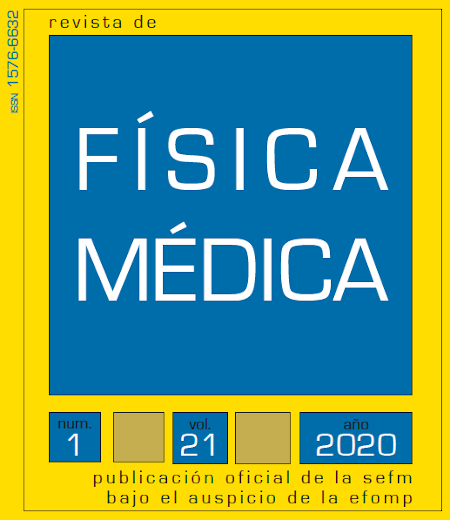Propuesta de un nuevo ajuste para el cálculo del rendimiento y análisis de su influencia en la estimación de la dosis glandular
DOI:
https://doi.org/10.37004/sefm/2020.21.1.002Palabras clave:
Dosis glandular, mamografía, tomosíntesis de mama, kerma, detectores en mamografíaResumen
En este trabajo se propone una nueva función de ajuste polinómica para la obtención del kerma en aire para cualquier kilovoltaje, frente al ajuste potencial recomendado por los protocolos europeo y español. Se ha medido el kerma y la capa hemirreductora en tres equipos de mamografía diferentes con cámara de ionización y detector semiconductor, para mamografía tanto en modo 2D como en tomosíntesis de mama. A partir de esos valores se ha estimado la dosis glandular siguiendo el modelo de Dance et al. Se ha obtenido una mejor adecuación entre el kerma medido y el calculado a la función propuesta que a la potencial. La estimación de la dosis glandular a partir del kerma obtenido mediante la función potencial de ajuste y la polinómica, muestran diferencias inferiores a un 2.5% en todos los equipos midiendo con la cámara de ionización, excepto para espesores de mama grandes (mayores de 6 cm). Sin embargo, las diferencias obtenidas entre los detectores utilizados han resultado mayores, encontrándose en torno al 10%. Por tanto, resulta fundamental conocer la respuesta de los diferentes detectores y el uso de una adecuada metodología de ajuste que minimice las incertidumbres obtenidas en la estimación de la dosis glandular.
Referencias
Yaffe MJ, Mainprize JG. Risk of Radiation-induced Breast Cancer from Mammographic Screening. Radiology 2011; 258(1):98-105.
International Comission on Radiation Units and Measurements. Conversion coefficients for use in radiolo- gical protection against external radiation. ICRU report 74: Oxford University Press;2005.
International Comission on Radiological Protection. Statement from the 1987 Como Meeting of the ICRP . Publication 52: Pergamon Press;1987.
Dance DR. Monte Carlo calculation of conversion factors for the estimation of mean glandular breast dose. Phys Med Biol. 1990;35(9):1211-9.
Dance DR, Skinner CL, Young KC, Beckett JR, Kotre CJ. Additional factors for the estimation of mean glandular breast dose using the UK mammography dosimetry protocol. Phys Med Biol. 2000;45(11):3225-40.
Dance DR, Young KC, Van Engen RE. Further factors for the estimation of mean glandular dose using the United Kingdom, European and IAEA breast dosimetry protocols. Phys Med Biol. 2009; 54(14): 4361-4372.
Sobol WT, Wu X. Parametrization of mammography norma- lized average glandular dose tables. Med Phys. 1997;24(4): 547-54.
Boone JM. Normalized glandular dose (DgN) coefficients for arbitrary x-ray spectra in mammography: computer-fit values of Monte Carlo derived data. Med Phys. 2002;29(5): 869-75.
Castillo M, Garayoa J, Estrada C, Tejerina A, Benítez O, Alcazar A, et al. Tomosíntesis de mama: mamografía sinte- tizada versus mamografía digital. Impacto en la dosis. Rev Senol Patol Mamar. 2015; 28(1): 3-10.
Zuley M, Bandos A, Ganott M, Sumkin J, Kelly A, Catullo V, et al. Digital Breast Tomosynthesis versus supplemental diag- nostic mammographic views for evaluation of noncalcified breast lesions. Radiology. 2013;266(1):89-95.
Skaane P, Bandos A, Eben E, Jebsen I, Krager M, Haakenaasen U, et al. Two-view digital breast tomosynthesis screening with synthetically reconstructed projection images: comparison with digital breast tomosynthesis with full-field digital mammographic images. Radiology. 2014;271:655- 63.
Skaane P, Bandos A, Gulien R, Eben E, Ekseth U, Haakenaasen U et al. Comparison of digital mammography alone and digital mammography plus tomosynthesis in a population-based screening program. Radiology. 2013;267: 47-56.
Dance DR, Young KC, Van Engen RE. Estimation of mean glandular dose for breast tomosynthesis: Factors for use with the UK, European and IAEA breast dosimetry protocols. Phys Med Biol. 2011;56: 453-71.
Sechopoulos I, Sabol JM, Berglund J, Bolch WE, Brateman L, Christodoulou E et al. Radiation dosimetry in digi- tal breast tomosynthesis: Report of AAPM Tomosynthesis Subcommittee Task Group 223. Med Phys. 2014; 41(9):091501.
Sechopoulos I, Suryanarayanan S, Vedantham SC, Karellas A. Computation of the glandular radiation dose in digital tomosynthesis of the breast. Med Phys. 2007;34(1): 221-32.
Gennaro G, Avramova-Cholakova S, Azzalini A, Chapel ML, Chevalier M, Ciraj O, et al. Quality Controls in Digital Mammography protocol of the EFOMP MammoWorking group. Phys Medica. 2018;48:55-64.
S. Avramova-Cholakova S, Vassileva J, Borisova R, Atanasova I. An estimate of the influence of the measurement procedure on patient and phantom doses in breast imaging. Radiat Prot Dosimetry. 2008;129(1-3):150-4.
Robson K J. A parametric method for determining mammographic X-ray tube output and half value layer. Br J Radiol 74. 2001;335-40.
Nickoloff EL, Berman HL. Factors affecting X-ray Spectra. Radiographics. 1993;13(6):1337-48.
EFOMP Mammo Working Group. Quality Controls in Digital Mammography. 2015.
SEFM, SEPR, SERAM. Protocolo Español de Control de Calidad en Radiodiagnóstico. Revisión 2011. Madrid: Senda Editorial; 2012.
R.E. Van Engen RE, Bosmans H, Bouwman RW, Dance DR, Heid P, Lazzari B, et al. Protocol for the Quality Control of the Physical and Technical Aspects of Digital Breast Tomosynthesis Systems. Version 1.03. Nijmegen; 2018.
Burden RL, Faires DJ, Burden AM. Approximation theory. Numerical Analysis. 10th edition. Boston: Cengage Learning; 2016.




